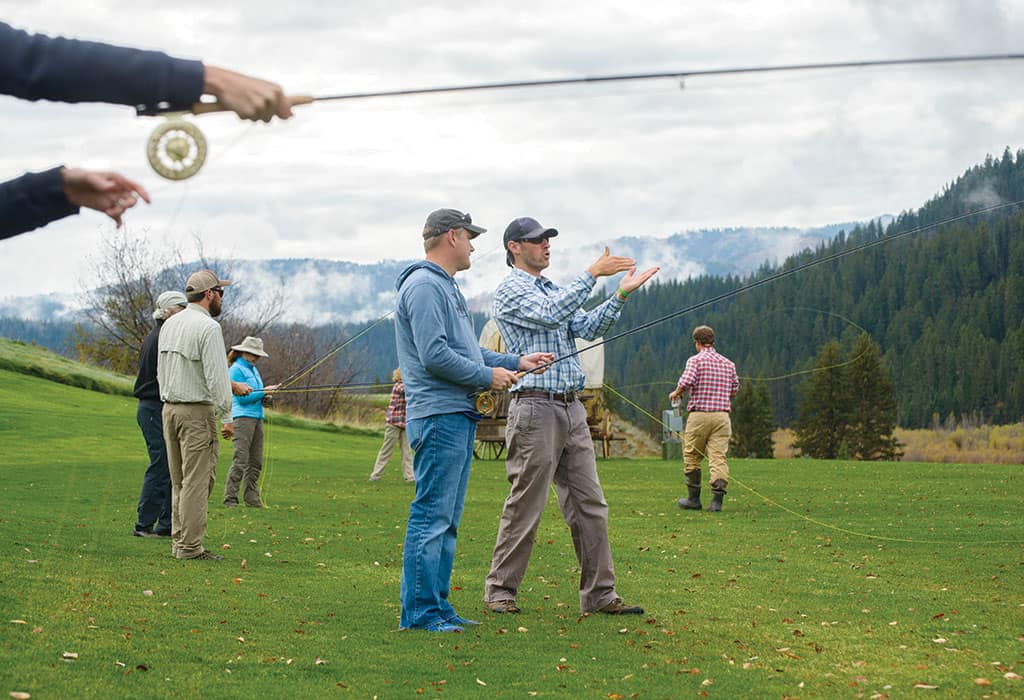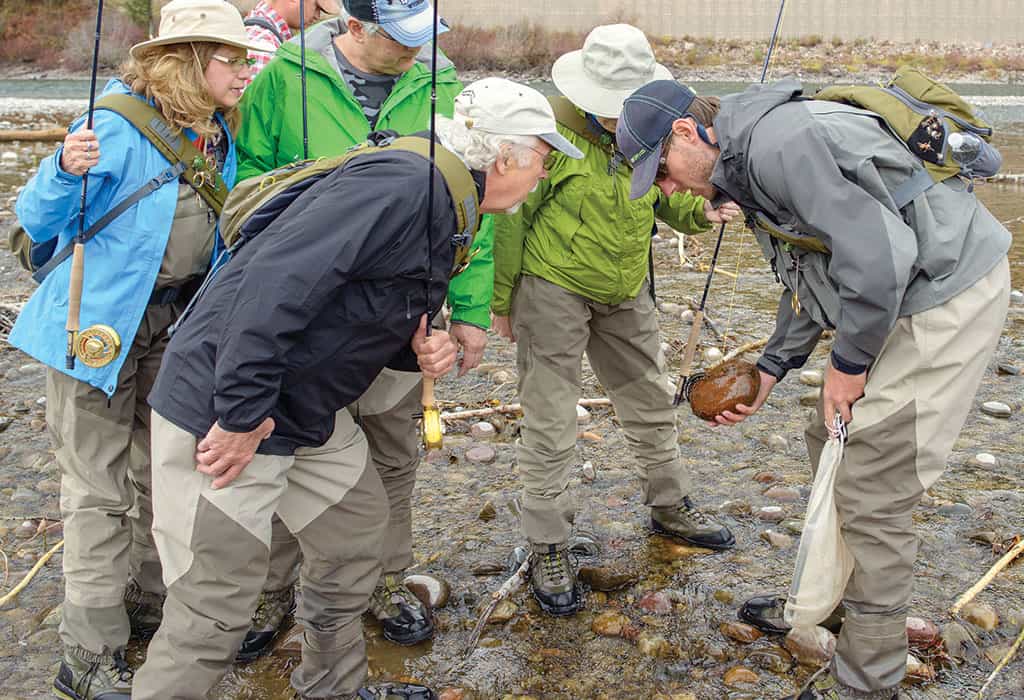Read The
Current Issue
Reel Estate
Brad Pitt made fly-fishing sexy, Jackson Hole instructors make the sport fun.
BY Joohee Muromcew
PHOTOGRAPHY BY price chambers

LEARNING HOW TO fly-fish reminds me a little of when I learned how to Nordic ski six or seven years ago. That winter, after a quick tutorial near the old Nordic barn at Jackson Hole Mountain Resort, my instructor led me out past the resort’s northern boundaries and into the beautiful solitude of the Laurance S. Rockefeller Preserve in Grand Teton National Park. For two hours we barely spoke—and not only because I was totally out of shape and breathless. The privilege of visiting such a tranquil sanctuary can and should elicit a reverential silence. In my second day of fly-fishing instruction, I once again feel that grateful awareness of my surroundings, even more rewarding when it’s earned and accessible through a noble sport.
It isn’t all quite the softly rumpled elegance of A River Runs Through It. A few times I am quite afraid of losing my ear. Luckily we are in the hands of Spencer Morton, two-time winner of the annual Jackson Hole One Fly competition and founder of the Jackson Hole Fly Fishing School (JHFFS). In 2015 JHFFS teamed up with the Orvis Company and the Snake River Sporting Club to offer professional instruction in a private setting along the Snake River. One of my eleven-year-old daughters, Mary, and I are invited to take a two-day course. Though having no experience fly-fishing, Mary has always been a natural fisherwoman. She is the most reliable provider of yellowfin tuna when our crew goes out deep-sea fishing during summers in Cape Cod. As Spencer hands me a rod, I have my usual ridiculous fears to overcome. What if the hook takes out my eye? Those wader overall things look hot and sweaty. What will I wear? I speak to Spencer at length about expectations for Mary and me. Being Spencer, who is also a beloved Jackson Hole Ski Club coach and Moose Hockey player, he laughs a little and then says, “You’ll be fine. Wear sunscreen.”

Our first day is a progression of lessons, beginning with classroom instruction in the Sporting Club’s lodge. Using the acclaimed Orvis curriculum, Spencer teaches us about trout species and ecology, and gives a very brief introduction to the gear. Having stumbled around a Cabela’s or two, I know we are just scratching the surface of rods, reels, and lines. Flies come on day two. We are joined by a gentleman, Bob, who has some experience fly-fishing and wants to brush up on his technique. Spencer keeps everything interesting and fast-paced. We move outside to a flat, grassy lawn to learn how to cast. “Whoa! Mary is a natural,” is the first thing I hear. She intuitively, and immediately, has that throw-snap motion down, her line landing perfectly straight on the verdant green lawn. I have issues. I cannot get my line to fall properly. It puddles up two feet in front of me, or sometimes behind me. Spencer patiently works with me until I get the hang of when to build up tension and when to release it. We work on adjusting for wind and aiming our line to a target.
We take lunch on the patio of the lodge’s dining room, a civilized break with good conversation and fun company. After lunch Spencer drives us to an area with small streams and pools, and still within the Snake River Sporting Club’s eight-hundred-acre property. We learn the art of choosing a fruitful fishing hole—how to judge the current, the sunlight on the water, the shady banks, and telltale patches of bubbly action. We learn to cast in these mild-mannered waters. Mary catches a few small fish. I catch my line on a lot of grasses.
We return for day two, again starting with classroom instruction, this time on flies. I’ve always found the array of colorfully spun, exotic-looking flies at sporting goods stores to be amusing and weird. They don’t look like flies. To continue the lessons of matching rod and line to fish and water, Spencer schools us on matching trout to its food. Flies are meant to mimic what the trout are eating at the exact moment in their lifespan and the season you’re hunting them. Today may be the day for grasshoppers, but at what life stage? Spencer has preserved specimens to show us, with fable-worthy names like Woolly Bugger and Royal Wulff.
We then pull on our gear—sized to us—which is provided by Orvis and selected by Spencer. He drives us to a remote part of the property. Then a short walk on a rough path leads us to a spectacular bend of the Snake River. Spencer unpacks a simple picnic lunch, which we enjoy with absolutely no one in sight. He spreads us out along the bank and works with us individually. Mary and Bob are well on their way—the fish pretty much jump out to greet them. I have to fuss around finding a spot before eyeing bubbles a bit further out. I cast, then cast again many more times before finding my confidence. The zing-whizz hum of the line becomes more rhythmic, and soon I forget about deadlines, grocery lists, to-dos, and not-to-dos. I do eventually catch a trout and scream like a teenager, nearly falling into the chilly water with excitement. Spencer is right there with his camera and congratulations. There I am under the shade of a willow tree, a cove of the Snake River most people could only hope to see from a float or drift boat. Just like that ski into the Rockefeller Preserve, it is a most privileged visit.





